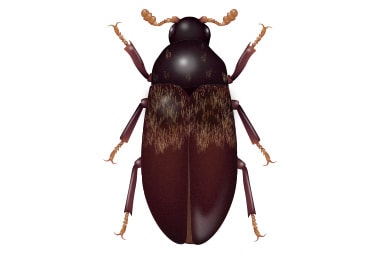
The larder beetle is a very common household pest that invades stored food products. They get their name from the fact that they prefer to feed on dried, cured meats and other types of food that are high in protein content. Larder beetles have a worldwide distribution.
| Pest Identification | |
|---|---|
| Recognition | Adult larder beetles grow to be about ¼ to 3/8th of an inch in length. They are dark brown or black with a light yellow colored band running across their body; within the light banding there are 6 or more dark spots. The larvae of the larder beetle are about ½ an inch in length. They are worm-like and tapered in shape. Their body is covered in stiff hairs. They have 3 pairs of legs, and they have 2 upward cured spines on their posterior end. |
| Biology | Female larder beetles lay their eggs in the spring and summer on a food source. The eggs will hatch and larvae will feed and molt 5-6 times. After the molting process is complete they will look for a place to burrow in order to pupate. They generally will choose a soft material like wood, books, or insulation. After pupating they will emerge as adult larder beetles. |
| Habits | Both the larvae and adult larder beetles feed on items that include meat, cheeses, dry pet food, other insects, furs, animal hides, and other foods that are high in fat and protein. Larder beetles often enter homes and other buildings through holes and spaces found in exterior walls and in the foundation. They can also enter your home when you purchase products that are already infested. After gaining entrance into a home, they will move to a dark, quiet place that provides them with easy access to food sources. Pantries, basements, and storerooms are all places that they are commonly found. |
| Prevention | In order to prevent problems with larder beetles in your home you should make sure to thoroughly inspect dry food items before purchasing them and bringing them into your home. Any products that have holes or tears in them should not be purchased. Remove dry goods from their original packaging and keep them in sealed plastic or glass containers, this is especially important for dry pet food. It is also important to seal any holes or cracks found in the exterior of your home or its foundation. |
| Professional | The most effective way to control larder beetles is through the help of a professional pest control expert. At Rottler, a trained technician will inspect for this pest and look for conditions that might attract larder beetles. Based on our findings, we’ll customize a treatment that gets rid of larder beetles. |

